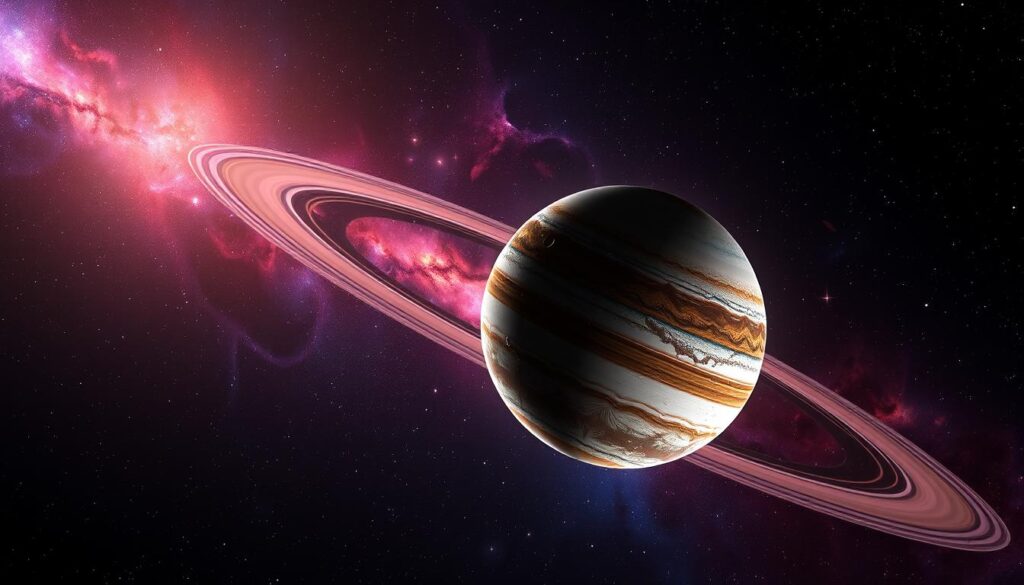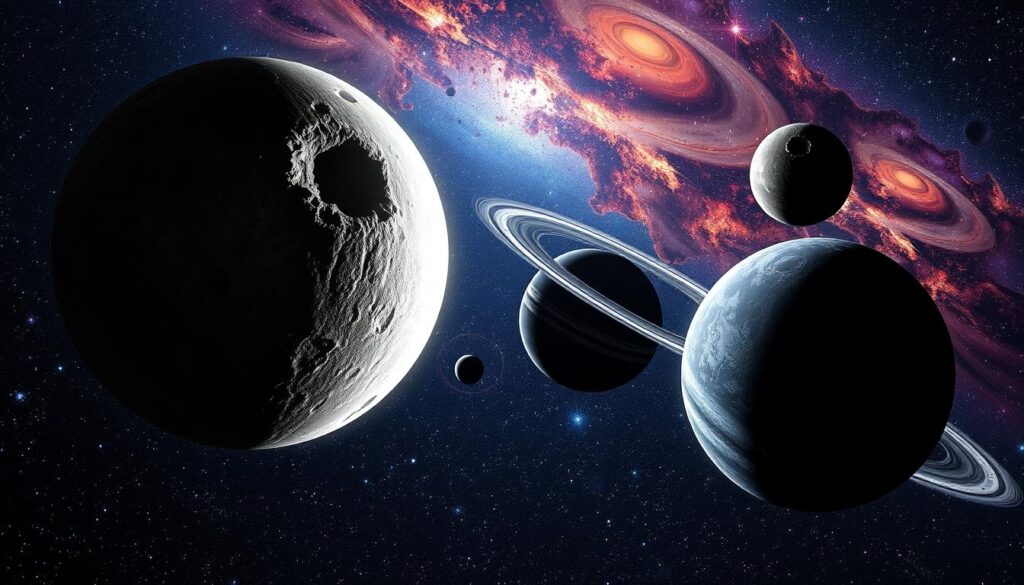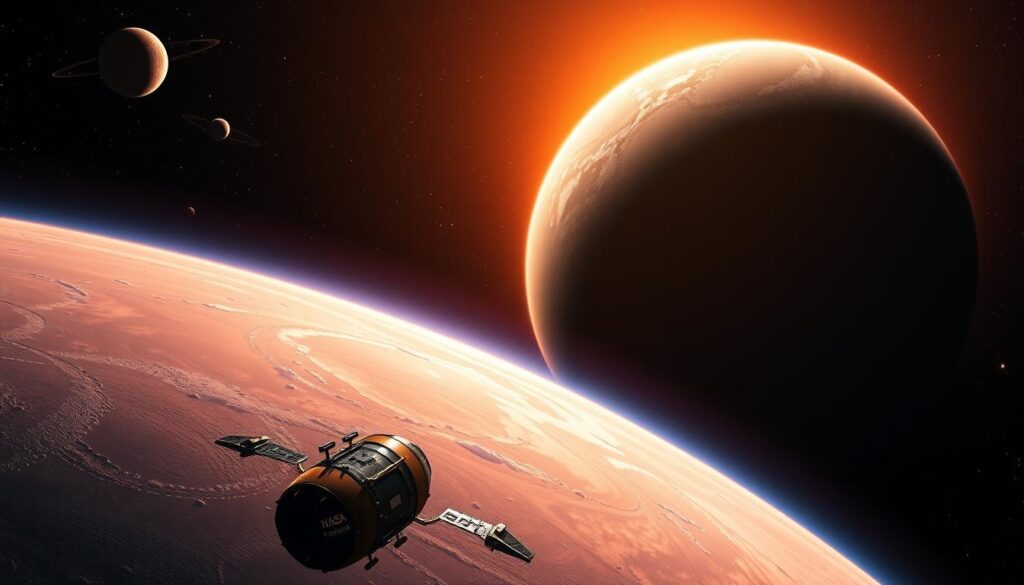
A distant dwarf planet in a starry cosmos, featuring icy surfaces and colorful geological formations, surrounded by faint rings, illuminated by a distant sun, with vibrant nebulae in the background.
In our vast solar system, there are tiny worlds that fascinate astronomers and space fans. These are the dwarf planets. They orbit the Sun and have special traits that make them different from big planets.
Dwarf planets are big enough to be round because of their own gravity. But they haven’t cleared their area of other small bodies. They are not satellites. These mysterious objects help us understand how our solar system formed and changed.
Key Takeaways
- Dwarf planets are celestial bodies that orbit the Sun but are not considered full-fledged planets.
- They have sufficient mass to overcome rigid body forces and achieve hydrostatic equilibrium.
- Pluto is the most well-known dwarf planet, but there are several others, including Ceres, Eris, and Makemake.
- Studying dwarf planets provides valuable insights into the formation and evolution of our solar system.
- NASA’s New Horizons mission has revolutionized our understanding of these tiny worlds.
From Pluto to Ceres, Eris, and Makemake, our solar system’s dwarf planets are full of secrets. Let’s dive into their world and learn about our solar system’s beginnings and how it works.
What are Dwarf Planets?
Dwarf planets are special bodies that orbit the Sun but don’t qualify as planets. They are big enough to be round due to their own gravity. Yet, they haven’t cleared their area of leftover debris from the solar system’s formation.
Definition and Characteristics
A dwarf planet orbits the Sun and is round due to its own gravity. But it hasn’t cleared its area of planetesimals. This means it’s big enough to be round but not the main body in its orbit.
Dwarf planets are like planets but can’t clear their area of debris. They are round and orbit the Sun. But they can’t dominate their orbit like a full planet can.
Dwarf Planet Criteria
The International Astronomical Union (IAU) set rules to tell dwarf planets from regular planets:
- The object must orbit the Sun.
- The object must be massive enough to be rounded by its own gravity.
- The object must not have cleared its neighboring region of planetesimals.
- The object must not be a satellite of another planet.
Pluto is the best-known dwarf planet. It meets these criteria and is seen as the first of its kind.
Discovering the Dwarf Planet Pluto
The discovery of Pluto, the most well-known dwarf planet, is a fascinating story in astronomy. In 1930, American astronomer Clyde Tombaugh found Pluto. He was looking for a ninth planet beyond Neptune. Pluto’s unique features and mystery have always intrigued scientists and the public.
At first, Pluto was seen as a full-fledged planet, the smallest and farthest in our solar system. But in 2006, the International Astronomical Union (IAU) changed its mind. They decided Pluto was a dwarf planet because it’s small and can’t clear its orbit of other objects.
Pluto’s discovery and its new status as a dwarf planet have sparked debates. It makes us question what makes a planet. This shows how complex our solar system is.
Now, Pluto is seen as a key part of the dwarf planet family. These bodies are like planets but don’t meet all the criteria. Studying Pluto and other dwarf planets helps us understand our solar system’s formation and evolution. It gives us a peek into the vast and changing universe.
Dwarf Planets in Our Solar System

A fantastical view of dwarf planets in the solar system, showcasing Ceres with its bright cratered surface, Haumea with its elongated shape and icy rings, Makemake surrounded by a field of frozen methane, and Eris shrouded in shadow, all set against a starry cosmic background with swirling nebulae and distant galaxies.
Pluto is well-known, but it’s not the only dwarf planet. There are many other dwarf planets in our solar system. Each one has its own special features and stories.
Ceres: The Largest Dwarf Planet
Ceres is the biggest dwarf planet. It orbits the Sun between Mars and Jupiter. It’s over 900 kilometers wide and was once thought to be an asteroid. In 2006, it was named a dwarf planet.
Ceres is a piece of the early solar system. It helps us learn about how our planets formed and changed.
Eris and Makemake: The Farthest Dwarf Planets
Eris and Makemake are the farthest dwarf planets from us. Eris is more massive than Pluto. It was found in 2005 and helped change Pluto’s status.
Makemake is the second-brightest in the Kuiper Belt after Pluto. Its name comes from the Rapa Nui people of Easter Island.
These dwarf planets, including Ceres, are fascinating to scientists. They help us understand our solar system better. Exploring them gives us new insights into the universe.
Exploring the Mysteries of Dwarf Planets

A stunning view of Pluto and its moons as seen from a spacecraft, with vibrant colors highlighting the icy surface and atmospheric haze, surrounded by a starry backdrop of deep space, showcasing NASA’s New Horizons mission spacecraft approaching in the foreground.
Dwarf planets have fascinated scientists and astronomers worldwide. These small bodies orbit the Sun and could reveal secrets of our solar system’s past. NASA’s New Horizons mission has led the way in exploring these mysteries.
NASA’s New Horizons Mission
The New Horizons spacecraft launched in 2006 aimed to study dwarf planets. Its first target was Pluto, reclassified as a dwarf planet in 2006. In 2015, it flew by Pluto, capturing images and data that changed our view of it.
The mission didn’t stop there. New Horizons then headed for Ultima Thule in the Kuiper Belt. This journey gave scientists a rare look at these small worlds. They learned about their composition, surface, and how they formed over billions of years.
“The exploration of dwarf planets through the NASA’s New Horizons mission has been a game-changer, revealing the mysteries of these tiny worlds and furthering our understanding of our solar system’s past.”
As New Horizons sends back data from its encounters, scientists are excited to learn more. They hope to uncover even more mysteries of dwarf planets that could change our view of our solar system’s history.
Conclusion
Dwarf planets are key to understanding our solar system and how it formed. Bodies like Pluto, Ceres, Eris, and Makemake give us a special view of our cosmic neighborhood. They help us learn more about the evolution of our universe.
Studying these small worlds has greatly expanded our knowledge of the solar system. By looking at their traits and actions, scientists gain insights into our planetary system’s formation. This helps us understand the early universe and the forces that shape it today.
It’s crucial to study dwarf planets. They might lead to major discoveries, expanding our cosmic knowledge. As we explore these mysterious bodies, we’ll likely find more secrets about our universe. This will deepen our awe for the wonders of the cosmos.
Important Point
| NO. | Important Points |
| 1. | About Us |
| 2. | Contact Us |
| 3. | Disclaimer |
| 4. | Privacy Policy |
FAQs of Dwarf planet
What are dwarf planets?
Dwarf planets are special bodies that orbit the Sun but don’t qualify as planets. They are big enough to be round due to their own gravity. Yet, they haven’t cleared their area of other small bodies.
What are the criteria for a celestial body to be considered a dwarf planet?
To be a dwarf planet, a body must orbit the Sun. It must also be big enough to be round by its own gravity. Lastly, it must not have cleared its area of other small bodies.
When was Pluto discovered, and how was it reclassified as a dwarf planet?
Pluto was found in 1930 and was first seen as a full planet. But in 2006, the International Astronomical Union (IAU) changed its status. They did this because of its size and the presence of other objects in its orbit.
What are the other known dwarf planets in our solar system?
Besides Pluto, Ceres is the largest dwarf planet. Eris and Makemake are also known dwarf planets. They are among the farthest objects in our solar system.
What is the significance of NASA’s New Horizons mission in exploring dwarf planets?
NASA’s New Horizons mission has given us new insights into dwarf planets, especially Pluto. This mission is exploring these small worlds. It could reveal many secrets about our solar system’s formation and evolution.
